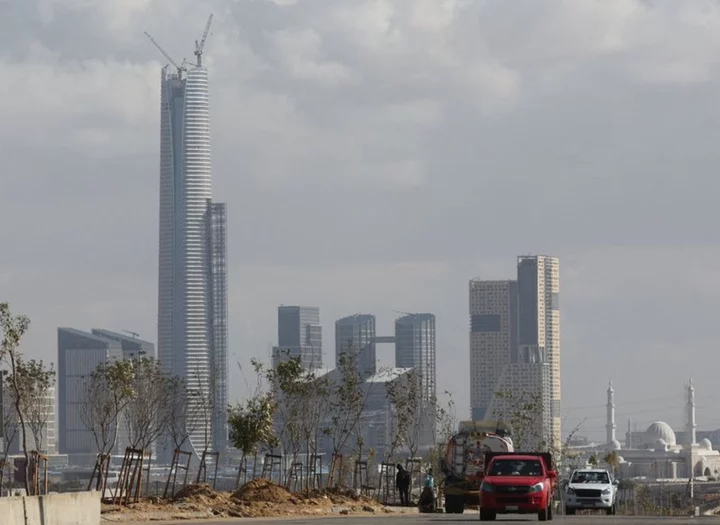By Lucia Mutikani
WASHINGTON (Reuters) -U.S. manufacturing slumped further in June, reaching levels last seen when the economy was reeling from the initial wave of the COVID-19 pandemic, according to a survey on Monday that also showed price pressures at the factory gate deflating.
Factories are resorting to laying off workers to manage headcounts, which ISM Manufacturing Business Survey Committee Chair Timothy Fiore said was "to a greater extent than in prior months," also noting that views about when "significant" growth would return were mixed.
At face value, the ISM survey is consistent with an economy that is in recession. But the so-called hard data, including nonfarm payrolls, first-time applications for unemployment benefits, consumer spending and housing starts, suggest the economy continues to grind along.
Risks of a downturn have, however, increased as businesses and consumers deal with the 500 basis points worth of interest rate increases from the Federal Reserve since March 2022, when the U.S. central bank embarked on its fastest monetary policy tightening campaign in more than 40 years.
"This provides further reason to suspect that a recession is on the horizon," said Andrew Hunter, deputy chief U.S. economist at Capital Economics.
The ISM's manufacturing PMI dropped to 46.0 last month, the lowest reading since May 2020, from 46.9 in May. That marked the eighth straight month that the PMI stayed below the 50 threshold, which indicates contraction in manufacturing, the longest such stretch since the Great Recession.
Economists polled by Reuters had forecast the index edging up to 47. Manufacturing, which accounts for 11.1% of the economy, contracted at a 5.3% annualized rate in the first quarter, government data showed last week.
Some pockets of strength remain, however, amid solid demand for goods like transportation equipment, machinery as well as electrical equipment, appliances and components.
The ISM survey showed that transportation equipment was the only one of the six biggest industries reporting growth last month. But even so, makers of transportation equipment expressed worries that second-quarter sales could decrease and boost inventory levels. They projected total end-of-year sales "to be about where we were last year."
Apart from the exorbitant borrowing costs, manufacturing is also being undermined by spending shifting to services from goods, which are typically bought on credit.
Businesses are also carefully managing inventories in anticipation of weak demand. Business inventories increased at their slowest pace in 1-1/2 years in the first quarter.
Economists say the sector has yet to feel the pain from a tightening in credit following financial market turmoil earlier this year. According to the ISM, 71% of manufacturing GDP contracted in June compared to 76% in May. But more industries declined sharply last month.
In addition to transportation equipment, printing, nonmetallic mineral products and primary metals reported growth in June. The 11 industry groups reporting contraction included wood products, textile mills, electrical equipment, appliances and components, machinery and computer and electronic products.
Stocks on Wall Street were trading higher. U.S. Treasury prices rose. The dollar was steady against a basket of currencies.
WEAK DEMAND
The ISM survey's forward-looking new orders sub-index climbed to a still-subdued 45.6 from 42.6 in May amid increased caution from businesses and consumers alike.
Computer and electronic products manufacturers said "customers are less inclined to purchase far in advance." Manufacturers of food, beverage and tobacco products noted that "there is an elevated level of capital project review as recession concerns loom."
Machinery manufacturers reported that "orders and business are steady with a healthy backlog, but new prospective orders seem to be getting pushed back into 2024."
Weak demand is depressing prices for inputs. The survey's measure of prices paid by manufacturers fell to 41.8 from 44.2 in the prior month as bottlenecks in the supply chain have eased considerably and higher borrowing costs dampen demand.
According to the ISM, the delivery performance of suppliers to manufacturing organizations has been faster for nine straight months. The economy has seen considerable goods disinflation. But services inflation, which is now the main focus, has remained sticky largely because of stronger wage growth from a tight labor market, as well as higher rents for housing.
The survey's gauge of factory employment dropped to 48.1 from 51.4 in May.
Though it has not been a reliable predictor of manufacturing employment in the government's nonfarm payrolls count, it aligns with expectations of slower job growth by year end.
Machinery, transportation equipment and food, beverage and tobacco products were the only three of the big six industry groups that increased employment. According to ISM's Fiore, "labor management sentiment at panelists' companies indicate a slowdown in hiring, with layoffs slightly more prevalent."
While manufacturing is deteriorating, housing appears to have stabilized and could even be recovering, thanks to a dearth of homes for sale.
A separate report from the Commerce Department on Monday showed spending on residential construction rebounded 2.2% in May after dropping 0.9% in the prior month, with investment in single-family housing projects accelerating 1.7%.
That contributed to boosting overall construction spending by 0.9% in May after gaining 0.4% in April.
(Reporting by Lucia Mutikani; Editing by Chizu Nomiyama and Andrea Ricci)









